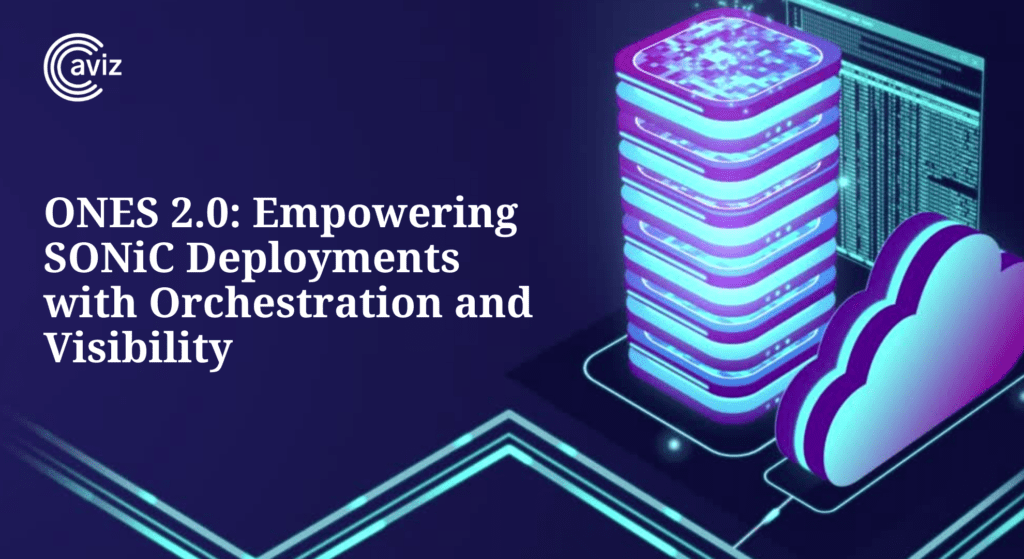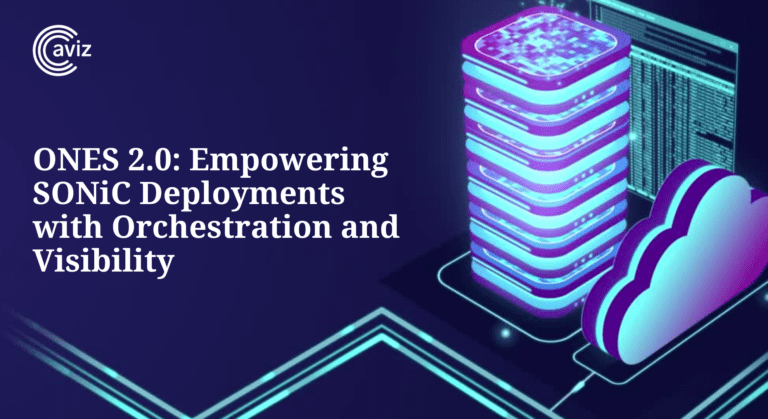We’re excited to introduce ONES 2.0, a cutting-edge network operations tool that sets new standards for Visibility, Orchestration, and Support. This release represents a significant leap in our ongoing commitment to pushing the boundaries of network management capabilities and orchestration.
Brimming with groundbreaking features, a polished user interface, improved data center orchestration through incremental configuration, upgraded NetOps APIs for seamless integration, and robust functionalities, ONES 2.0 empowers network teams to effortlessly streamline operations, delve into deeper insights, and ensure peak performance.
Get ready to embark on a journey where innovation meets excellence, as ONES 2.0 empowers your network endeavors with unparalleled sophistication and efficiency. It’s not just a tool; it’s a game-changer, designed to elevate your network experience to unprecedented levels. Welcome to ONES 2.0 !

Unlocking Data-Driven Success: 6 Key Benefits of Enhanced Telemetry
1. Data Center Interconnect Visibility
Enhance visibility of Data Center Interconnect topologies for Layer-2 Leaf-Spine, Rack-to-Rack Connectivity using EVPN-VXLAN and MC-LAG including control plane health and configurations.
2. Rule Engine and Alerts
Experience a robust Rule Engine and Alerts system integrated with Slack messaging and Zendesk ticketing. Monitor platform metrics, health, traffic bandwidth, and more. Stay proactive with customizable alerts and automatic ticketing.


3. AI-Fabric Control & Data Plane Visibility
Gain visibility into RoCE (RDMA over Converged Ethernet) metrics and RoCE link visibility for improved performance monitoring and visualize traffic flows on the topology page.

4. Firmware Compliance
Stay up-to-date with detailed firmware information for each switch, covering ONIE, BMC, BIOS, FPGA, and CPLD versions.

5. Enhanced Supportability Functions
- Syslog Management: Simplify troubleshooting with a programmatic click in UI to collect the logs from devices, supported directly from the topology page.
- Console Access and Inventory Download: Seamlessly access the console of switches directly from the ONES interface, simplifying device management. Effortlessly download the inventory details of all devices for efficient asset management.
6. Network SLA: Packet Loss & Latency
ONES 2.0 incorporates exclusive back-end support for Network SLA, enabling users to monitor packet loss and latency between any two end-points, measured using ICMP or TCP.
How does NetOps Ready Orchestration enhance enterprise deployments?
Incremental Config
ONES 2.0 adds support for incremental configuration changes. You may now deploy a template to configure your fabric and progressively update VLANs/VNIs across the fabric. This agility makes your network designs more adaptable.
Improved NetOps API
The NetOps API has been improved in 2.0 to accommodate several underlay configurations, including seamless underlay and overlay configuration. This capability not only provides for a broader range of use-cases, but also handles more deployment scenarios such as L2LS, L3LS, and flexible configuration and elastic scaling of spine and leaf nodes
New Use Cases & Features
- L3 MC-LAG
While L2 MC-LAG was already supported, ONES 2.0 adds L3 MC-LAG. This provides redundancy, load balancing, scalability, and easier management to meet diverse networking difficulties. Improve your network’s performance and reliability across a wide range of use scenarios. - Layer2 Leaf-Spine (L2/L3 Mode)
Designed to meet the escalating demands of modern data centers, the Layer2 Leaf-Spine architecture offers low-latency, high-bandwidth connectivity with redundancy and efficient traffic distribution. - Rack-2-Rack Deployment
A deployment scenario tailored for fabrics designed with interconnection with leaf devices exclusively, eliminating the need for spines. This streamlined configuration suits specific network architectures. - BGP Peering over LAG
Enable higher bandwidth, load balancing, and redundancy with this configuration use case. Multiple physical links are aggregated into a logical bundle, known as a PortChannel, optimizing network performance. - BGP Peering in MC-LAG Environments
Configuring BGP peering among MC-LAG peers over the PeerLink ensures seamless operations during uplink failures, while additional interface peering expands network capabilities for optimized traffic handling and heightened resilience. - sFlow & DHCP Relay Support
ONES orchestration tool’s recent support for sFlow and DHCP Relay within the data center, unlock a new level of network management. - Console Log
ONES 2.0 provides administrators with a centralized console plane from which they can monitor network activity for various devices.This is quite useful for tracking the progress of the operation and recording logs in case of problems.

- Monitoring Configuration & Operational Status
In our latest release, track orchestration progresses seamlessly through our intuitive GUI. Gain real-time visibility into the progress of operational validation, empowering you to monitor every stage of your network’s deployment and verification with ease.

Explore the power and versatility of ONES 2.0 for SONiC with these exciting new features and UI enhancements. Elevate your network orchestration and management to new heights!
Conclusion
In summary, ONES 2.0 represents a significant advancement in network operations and management, establishing new standards in visibility, orchestration, and support. Packed with innovative features, an enhanced user interface, and expanded capabilities, ONES 2.0 empowers network teams to streamline operations, gain profound insights, and effortlessly ensure peak performance.
What’s next in our upcoming blog series, stay tuned to know following insightful topics:
- Rule Engine, Alerts, and Notifications
- RoCE Traffic Visibility in AI Fabric
- Detailed Security Compliance with ONES
- In-depth Analysis of NWSLA Measurement
Immerse yourself in the transformative capabilities of ONES 2.0 for SONiC, and join us on a journey toward seamless network monitoring and orchestration. Unlock the ONES 2.0 experience—schedule a demo on your preferred date, and let us show you how it’s done!
FAQs
1. What makes ONES 2.0 a game-changer for SONiC network operations?
ONES 2.0 revolutionizes SONiC network management with enhanced Visibility, Orchestration, and Supportability. It introduces incremental configuration, upgraded NetOps APIs, advanced telemetry, and rule-based alerts—allowing network teams to streamline operations, gain deeper insights, and optimize performance seamlessly.
2. How does ONES 2.0 improve network visibility and telemetry?
ONES 2.0 offers AI-Fabric control plane insights, RoCE traffic visibility, and Data Center Interconnect telemetry. It provides a real-time topology view, enriched metrics on health, traffic, and capacity, and deep insights into firmware compliance and device performance—empowering proactive network monitoring.
3.What orchestration and automation features does ONES 2.0 introduce?
ONES 2.0 enhances orchestration with YAML-based templates, incremental configuration updates, and automated L2/L3 fabric management. It also introduces seamless BGP peering, MC-LAG redundancy, and elastic scaling for leaf-spine architectures—optimizing network deployment efficiency.
4. How does ONES 2.0 enhance security and compliance in SONiC environments?
ONES 2.0 strengthens security with RBAC enforcement, mutual TLS certificates, and LDAP integration. It ensures firmware compliance by tracking ONIE, BMC, BIOS, FPGA, and CPLD versions—helping enterprises maintain a secure and standardized network infrastructure.
5. What are the key supportability features in ONES 2.0?
ONES 2.0 simplifies troubleshooting with syslog management, centralized console access, and inventory downloads. It also supports Network SLA monitoring, allowing users to measure packet loss and latency between endpoints via ICMP or TCP, ensuring optimal network health.
6. How does ONES 2.0 handle firmware compliance across multi-vendor environments?
ONES 2.0 provides comprehensive firmware visibility for each switch, tracking critical components like ONIE, BMC, BIOS, FPGA, and CPLD versions. This enables consistent firmware governance across multi-vendor deployments, helping enterprises maintain standardized and compliant infrastructure with ease.
7. What new use cases are supported in ONES 2.0 for modern data centers?
ONES 2.0 introduces support for L3 MC-LAG, BGP peering over MC-LAG and PortChannel, Layer2 Leaf-Spine topologies, and Rack-to-Rack deployments. These configurations address growing needs for scalability, redundancy, and simplified architecture, making the platform ideal for modern, elastic network fabrics.
8. How does ONES 2.0 help monitor packet loss and latency for SLA enforcement?
ONES 2.0 includes backend support for Network SLA monitoring, allowing administrators to measure packet loss and latency between endpoints using ICMP or TCP probes. These insights enable proactive SLA assurance and help fine-tune network performance to meet business-critical requirements.
9. What is the significance of console access and syslog management in ONES 2.0?
ONES 2.0 introduces centralized console access directly from the topology UI, enabling faster troubleshooting. With programmatic syslog collection, admins can gather logs from switches in one click, drastically reducing MTTR and improving operational visibility across the network.
10. How does ONES 2.0 enable real-time operational tracking and orchestration status?
ONES 2.0 offers intuitive GUI-based orchestration tracking, displaying configuration progress and operational validation in real time. This helps network teams visually monitor every stage of deployment, verify configurations instantly, and gain confidence in changes before production rollout.





